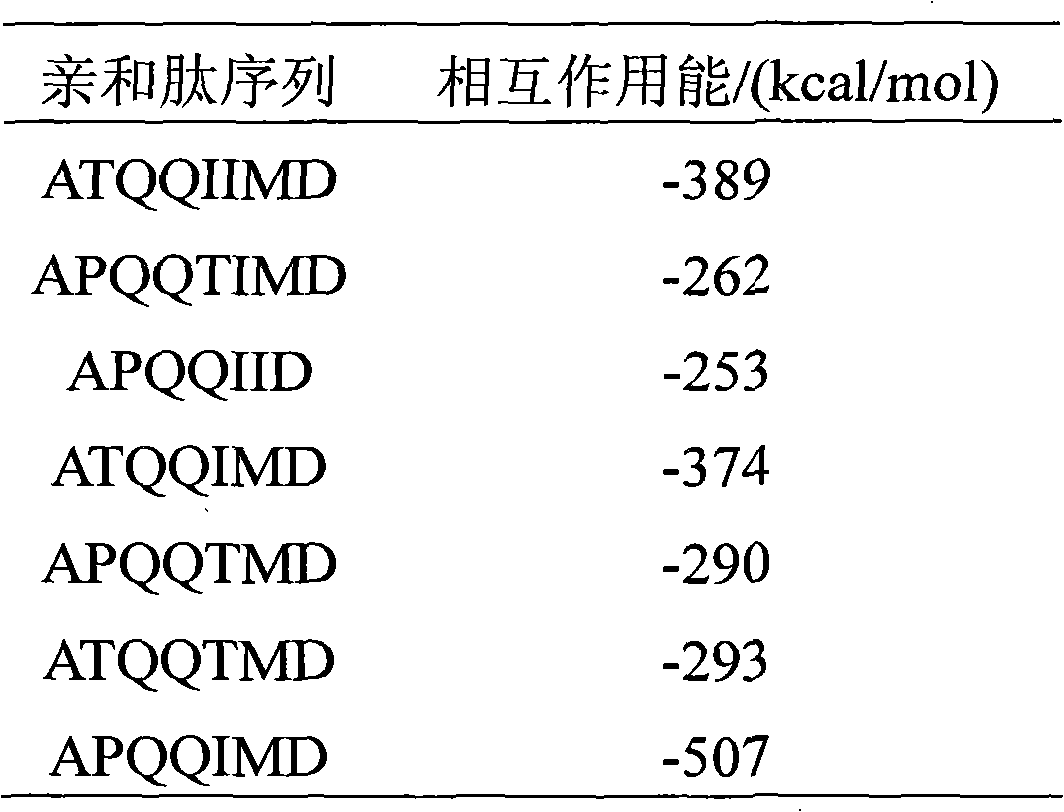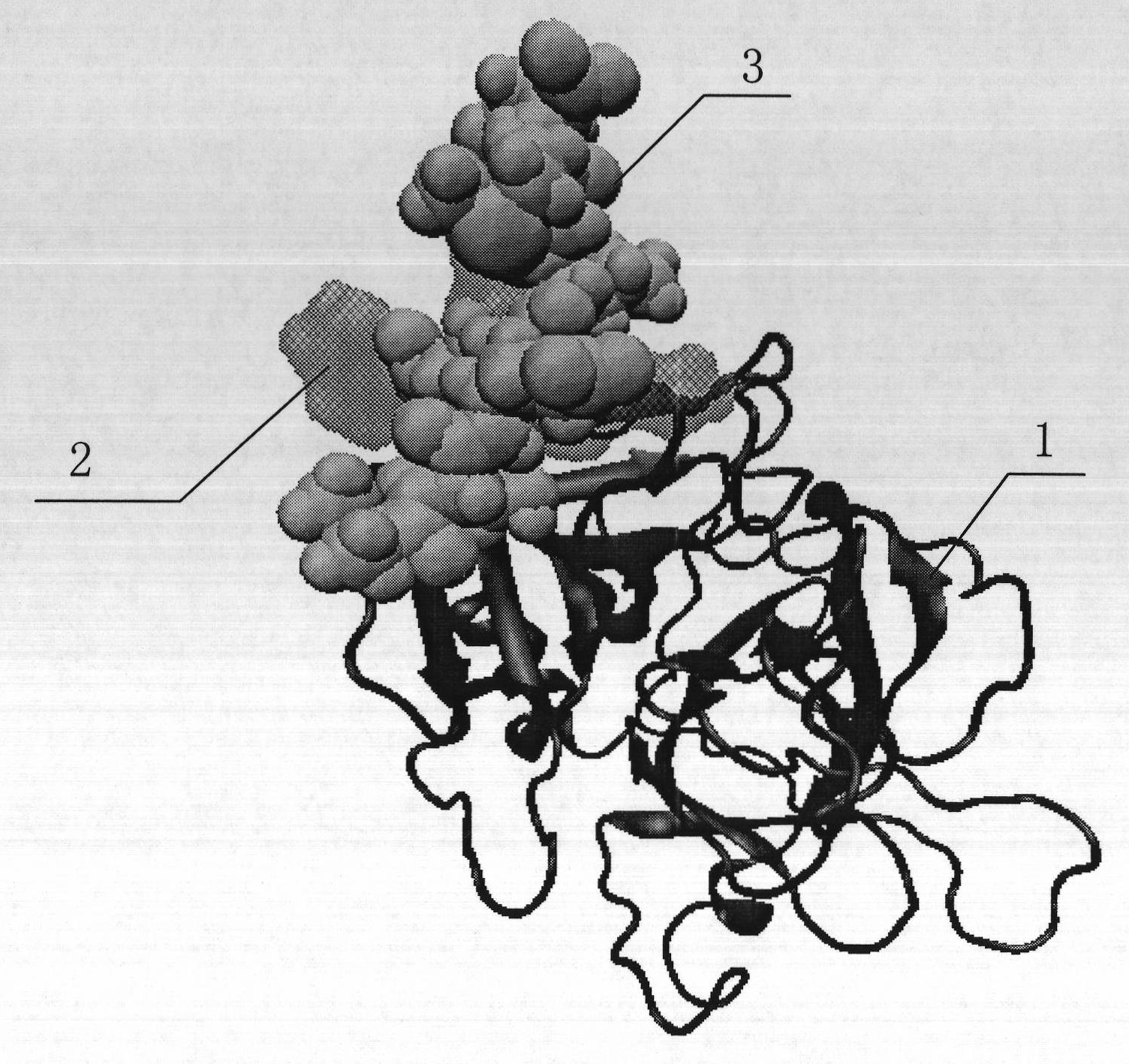Affinity peptide for tissue-type plasminogen activator and fragment of activator, and application thereof
A technology of plasminogen and activator, which is applied in the field of affinity peptides, can solve the problems of lack of effective methods for separating and purifying tissue-type plasminogen activator, and achieve good separation and purification effect, less immune reaction of the body, strong affinity Harmonious effect
- Summary
- Abstract
- Description
- Claims
- Application Information
AI Technical Summary
Problems solved by technology
Method used
Image
Examples
Embodiment 1
[0020] Example 1: Design of tissue-type plasminogen activator and its fragment affinity peptide ligand
[0021] The affinity peptide of the invention adopts the method of molecular dynamics and is designed based on the action sites of tissue-type plasminogen activator and plasminogen activator inhibitor.
[0022] The three-dimensional structures of tissue-type plasminogen activator and plasminogen activator inhibitor were taken from the Protein Data Bank (pdb). Select the B chain of plasminogen activator inhibitor, its residue sequence is as follows: Met-Ala-Pro-Glu-Glu-Ile-Ile-Met-Asp-Arg-Pro-Phe-Leu-Phe-Val -Val-Arg-His-Asn-Pro-Thr-Gly-Thr-Val-Leu-Phe-Met-Gly-Gln-Val-Met-Glu-Pro, using the thirty-three tripeptide as the affinity peptide, at room temperature Molecular dynamics simulation of tissue-type plasminogen activator at least 4ns in water and water environment, during which the affinity peptide and tissue-type plasminogen activator are allowed to freely adsorb, and th...
Embodiment 2
[0027] Example 2: Analysis of affinity peptides of tissue-type plasminogen activator and its fragments and their interaction energy
[0028] Using the method described in Example 1, with the threonine mutation system (i.e. respectively X 2 x 5 x 6 site mutation to threonine) as an example, using the formula (1) to calculate the interaction energy between each affinity peptide and tissue-type plasminogen activator, the results are shown in Table 1.
[0029] E. int =E P+L -E P -E L (1)
[0030] In formula (1), E int Indicates the interaction energy between tissue-type plasminogen activator and affinity peptide, E P+L Indicates the total potential energy of tissue plasminogen activator and affinity peptide, E P Indicates the potential energy of tissue plasminogen activator, E L Indicates the potential energy of the affinity peptide.
[0031] Table 1 Analysis of results of tissue plasminogen activator and different affinity peptide ligands
[0032]
[0033] It c...
Embodiment 3
[0038] Example 3: Affinity peptide ligands of tissue-type plasminogen activator and its fragments are linked to a solid phase carrier
[0039] The polyvinyl alcohol hydrogel system is formed by cross-linking six polyvinyl alcohols, each chain is composed of 40 polyvinyl alcohol monomers, and each chain is connected with 5 structures as shown in SEQ ID Nos.1 For the affinity peptide, carry out a molecular dynamics simulation of at least 4ns, and use the formula (1) to calculate the interaction energy between the affinity peptide and tissue-type plasminogen activator after immobilization, and the interaction energy between the affinity peptide and tissue without immobilization The interaction energy of plasminogen activators is comparable. It can be known that the immobilized affinity peptide has good affinity and can be used for separation and purification or detection of tissue plasminogen activator or its fragments.
PUM
 Login to View More
Login to View More Abstract
Description
Claims
Application Information
 Login to View More
Login to View More - R&D Engineer
- R&D Manager
- IP Professional
- Industry Leading Data Capabilities
- Powerful AI technology
- Patent DNA Extraction
Browse by: Latest US Patents, China's latest patents, Technical Efficacy Thesaurus, Application Domain, Technology Topic, Popular Technical Reports.
© 2024 PatSnap. All rights reserved.Legal|Privacy policy|Modern Slavery Act Transparency Statement|Sitemap|About US| Contact US: help@patsnap.com










